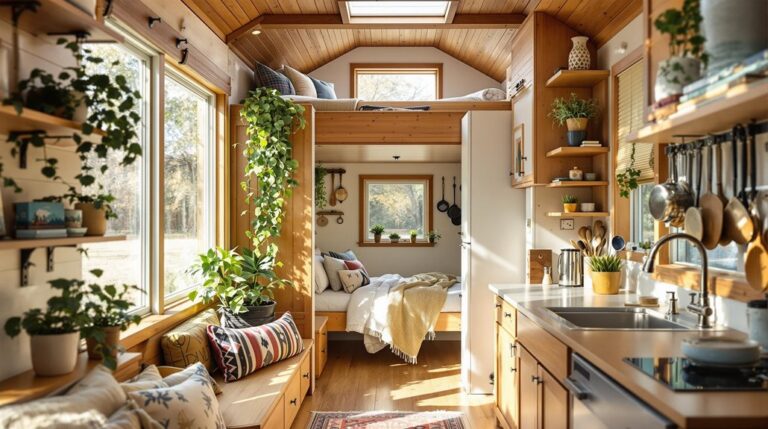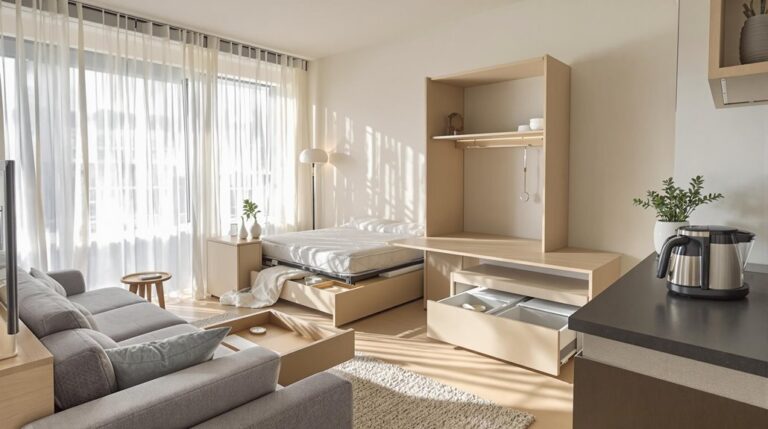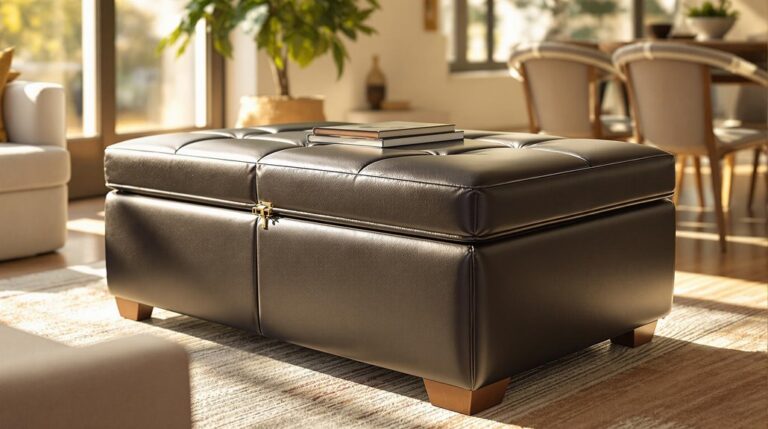The modern bedroom serves multiple functions beyond simply housing a bed. Downsizing this personal space requires thoughtful planning and selective furnishing choices. Today’s compact living arrangements demand furniture that performs dual roles while maintaining aesthetic appeal. Storage solutions must work harder in limited square footage, often hiding in plain sight or utilizing overlooked vertical dimensions. With strategic organization and multi-functional pieces, even the smallest bedrooms can offer comfort without clutter. The transformation begins with a critical assessment of necessities versus luxuries.
Key Takeaways
- Multi-functional furniture like storage beds and fold-away desks maximize space efficiency in smaller bedrooms.
- Wall-mounted shelving and ceiling-height storage solutions utilize vertical space without consuming floor area.
- Under-bed storage containers with wheels and transparent panels offer hidden organization for seasonal items.
- Streamlined dressers with adjustable shelving systems provide versatile storage in compact footprints.
- Strategic placement of furniture against walls and implementation of clearance zones ensures comfortable movement in downsized spaces.
Assessing Your Space: The First Step to Successful Downsizing
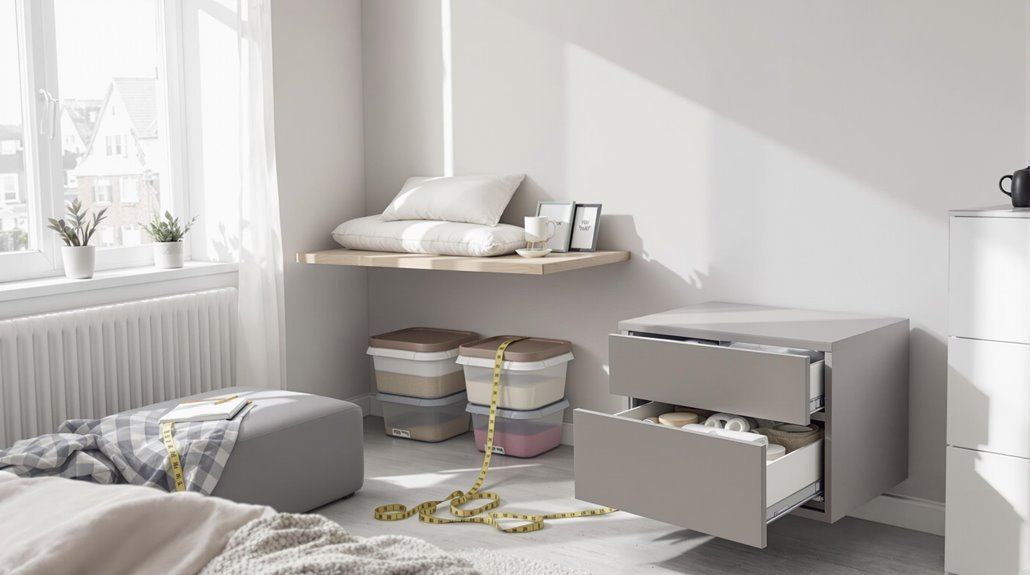
When initiating a bedroom downsizing project, how does one begin the essential process of space assessment? Proper space measurements form the foundation of successful planning. Using a professional-grade measuring tape (25+ feet), carefully document the room’s length and width in feet and inches, noting architectural irregularities such as alcoves or angled walls.
Create scaled sketches that include door swing trajectories and window placements to visualize constraints. Layout analysis involves evaluating both horizontal and vertical dimensions. Measure ceiling heights to determine appropriate furniture scale, and identify fixed obstacles like radiators or vents that affect placement options.
Calculate usable versus total space by distinguishing between gross square footage and functional zones. For irregular rooms, divide the space into smaller rectangles for accurate area calculations. Remember to mark clearance zones of 18-24 inches around doors and pathways to guarantee comfortable movement throughout the downsized space.
Multi-Functional Furniture Pieces That Maximize Small Bedrooms
Nearly every square inch counts in a downsized bedroom, making multi-functional furniture an essential investment rather than a luxury option.
Multi-functional beds, particularly those with built-in storage drawers or lift-up frames, eliminate the need for separate dressers while providing ample space for linens, seasonal clothing, and personal items.
Smart storage beds don’t just offer comfort—they eliminate extra furniture while housing essentials discreetly beneath.
For those whose bedrooms double as home offices, wall-mounted desks that fold away when not in use preserve precious floor space.
Compact dressers with adjustable shelving systems maximize vertical storage while minimizing footprint.
Ottomans that serve as seating, storage, and occasional tables represent another space-saving solution.
As urban living spaces continue to shrink—with the average new home now measuring just 2,179 square feet—these versatile furniture pieces help maintain functionality without sacrificing comfort or style.
Vertical Solutions: Utilizing Wall Space When Floor Space Is Limited
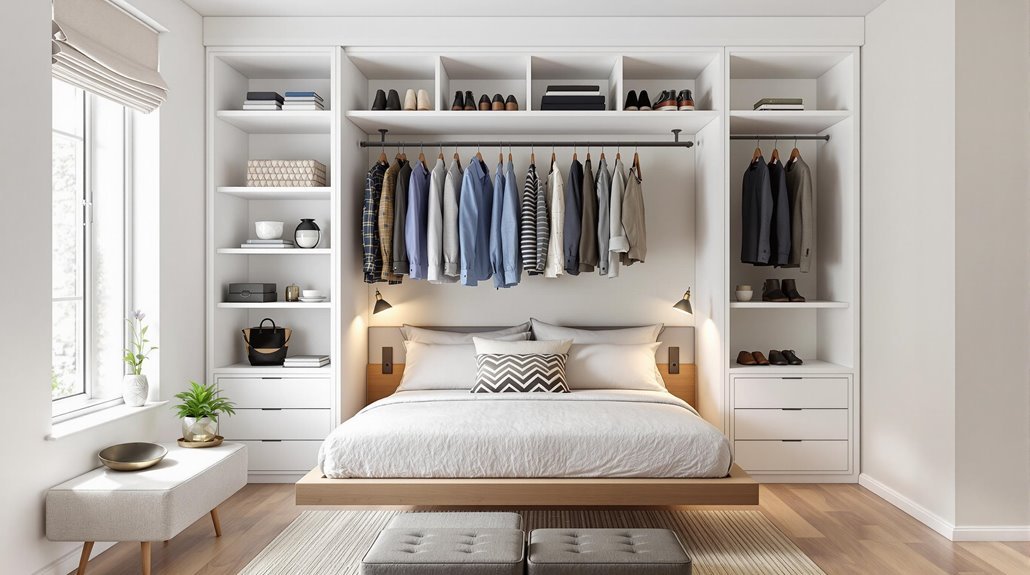
Limited floor space demands a vertical perspective when organizing a downsized bedroom. Wall-mounted shelves provide essential storage without consuming precious floor area, while creating visual interest through strategic placement.
Consider installing modular wall units that can be customized based on changing storage needs for books, linens, or decorative items.
For those seeking both function and style, mirror-faced cabinets serve dual purposes—concealing belongings while visually expanding the room.
Decorative hooks offer practical hanging solutions for everyday items like robes and accessories, eliminating clutter.
Ceiling-height bookshelves maximize vertical space, creating a seamless shift between storage and display areas.
For areas above the bed, open-concept ledges provide perfect spots for framed photos or small collectibles, transforming necessary storage into thoughtful design elements that complement your bedroom’s aesthetic.
The Under-Bed Frontier: Storage Options That Disappear From View
The space beneath a bed represents one of the most underutilized storage frontiers in modern bedrooms, offering significant square footage that typically remains hidden from view.
Unlock the hidden real estate beneath your bed—a secret storage frontier awaiting your organizational touch.
Market trends show consistent growth in under-bed storage solutions, particularly from July through December when seasonal decluttering peaks.
Modern under bed bins now include innovative designs like wheeled containers with transparent panels for easy identification, and modular containers featuring hinged lids that eliminate heavy lifting.
These solutions are especially valuable for urban dwellers facing space constraints.
For ideal organization, consider specialized options: airtight, cedar-lined bins for off-season clothing; sliding metal-framed containers for accessories; or stackable modular containers for bedding.
When selecting storage, prioritize breathable materials for garments and compression technology for bulky items to maximize this valuable hidden storage real estate.
Smart Closet Systems That Transform Limited Wardrobe Space
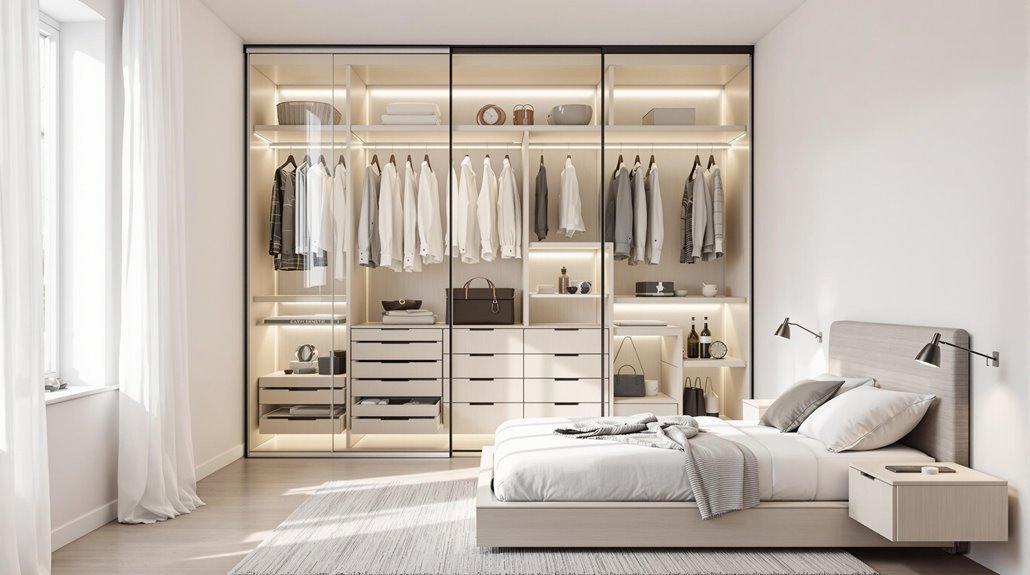
Smart closet systems have revolutionized how homeowners maximize limited wardrobe space, particularly in compact urban dwellings where every square inch matters.
These solutions combine modular design with smart technology to deliver unprecedented wardrobe flexibility.
Modern systems feature adjustable configurations with telescoping rods and expandable shelves that adapt to different room dimensions, while motorized automation allows racks to adjust at the touch of a button.
The integration of LED lighting and charging stations further enhances functionality, reflecting the growing European and South Korean preference for multi-functional features.
For those committed to smart organization, inventory tracking sensors and companion apps help monitor clothing stock, making seasonal shifts seamless.
The market for these innovative solutions continues to expand, projected to grow from $2.98 billion in 2023 to $8.2 billion by 2031, driven by urbanization and the increasing demand for space-optimizing solutions.
Light and Color Strategies to Create the Illusion of Larger Rooms
Creating an illusion of spaciousness in compact bedrooms requires strategic manipulation of light and color, two powerful design elements that can transform even the smallest spaces into visually expansive retreats.
Leveraging color psychology, homeowners should prioritize lighter shades like whites, creams, and sage green on walls and ceilings to reflect light and draw the eye upward. Contrasting wall colors can strategically alter spatial perception—placing darker tones on the front wall while keeping side walls light creates a “push/pull” effect that visually widens the room.
For maximum light reflection, incorporate glossy finishes and mirrors alongside layered lighting fixtures that eliminate harsh shadows. Combining ambient illumination with targeted task lighting guarantees even brightness throughout, while matching trim colors with walls maintains an unbroken visual flow that enhances perceived dimensions.
Technology Integration for Space-Efficient Bedroom Functionality
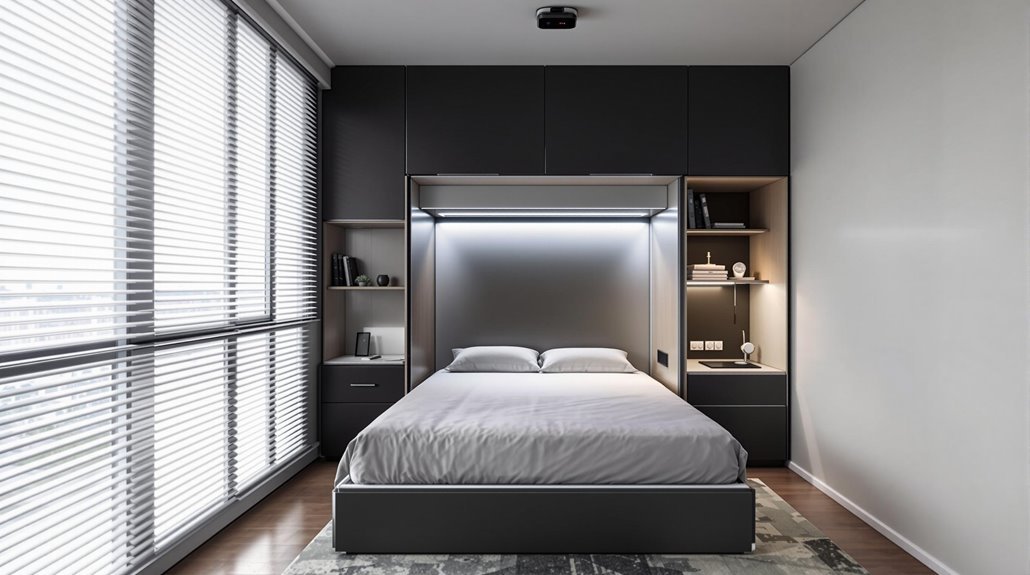
Beyond color and lighting considerations, modern technology offers powerful solutions for maximizing functionality in limited bedroom spaces. By integrating smart lighting systems with customizable brightness and color adjustments, smaller bedrooms can transform to accommodate different activities throughout the day.
Motion-activated sensors eliminate the need for physical switches, preserving valuable wall space and enhancing accessibility.
Climate control technology further optimizes compact bedrooms through smart thermostats that learn occupancy patterns and adjust temperatures accordingly. These systems can be controlled remotely, ensuring comfort without sacrificing square footage to bulky traditional units.
Automated window treatments work in tandem with climate systems, regulating light and temperature while eliminating the need for space-consuming manual controls.
Multi-functional furniture with integrated charging stations and smart sleep optimization devices complete the technology ecosystem, allowing residents to enjoy full functionality without spatial compromise.
Budget-Friendly Approaches to Downsizing Your Sleep Space
While luxury renovation projects often dominate home improvement discussions, transforming a bedroom into a smaller, more efficient space can be accomplished without breaking the bank. Affordable layout adjustments like positioning bed frames flush against walls and implementing monochromatic paint schemes create visual harmony in compact spaces.
Budget bedding options work best when paired with minimalist decor principles—lightweight curtains replace heavy draperies, while reflective surfaces amplify natural light. Repurposing vintage items adds character without significant expense.
Wall-mounted headboards save precious floor space while twin-size beds offer practical solutions for shared rooms. For storage, utilize under-bed crates and high shelving above doorways to maximize vertical space.
Convert awkward alcoves into reading nooks with simple built-in shelves, and incorporate open baskets in corners to maintain organization while concealing functional elements like vents.
Seasonal Storage Rotation: Managing Belongings Year-Round
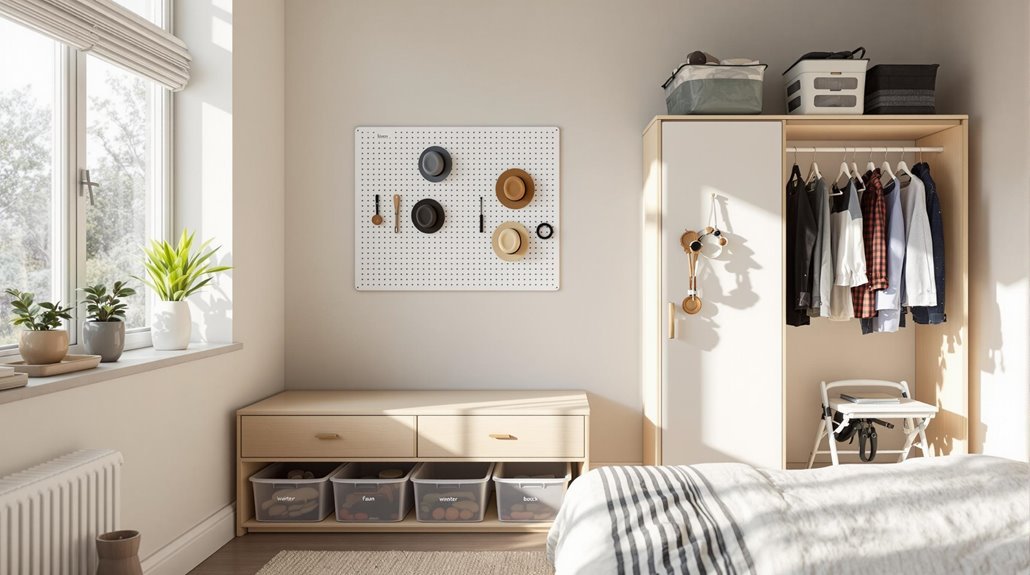
Successful bedroom downsizing ultimately depends on effectively managing seasonal belongings throughout the year.
Implementing a structured seasonal rotation system maximizes precious closet space while extending the lifespan of clothing through proper storage. The most effective approach begins with purging unworn items before categorizing belongings by both type and season, rather than strict seasonal divisions.
Smart storage begins with ruthless purging and then organizing by both function and season.
Essential storage solutions include vacuum-sealed bags for bulky winter garments, clear labeled bins for accessories, and under-bed containers for off-season footwear.
Organizing the closet with dedicated high zones for winter items and low compartments for summer pieces creates an intuitive system.
Quarterly evaluations help track usage patterns and identify candidates for donation. This methodical rotation not only reduces clutter-related stress but supports sustainability by minimizing textile waste through mindful storage practices.
Maintaining Comfort and Style While Reducing Square Footage
Reducing bedroom square footage does not have to mean sacrificing comfort or personal style when approached with strategic planning.
Compact furniture alternatives like nesting tables and streamlined dressers with vertical pulls preserve floor space while maintaining functionality. Incorporating minimalist decor principles naturally complements smaller spaces, allowing carefully chosen pieces to make stronger visual statements.
Multi-functional furniture, such as storage bed frames and bookshelf-table combinations, serves dual purposes while eliminating redundant pieces.
Floating shelves that double as bedside tables maintain open floor areas, creating the impression of spaciousness. Cozy textiles in thoughtful color palettes add warmth without overwhelming the reduced dimensions.
King bed frames with built-in storage compartments eliminate the need for additional dressers, while modular wardrobes with sliding panels adapt perfectly to compact layouts.
Frequently Asked Questions
How Do I Downsize Without Sacrificing Privacy in Shared Bedrooms?
To maintain privacy in shared bedrooms while downsizing, one should strategically implement privacy screens and room dividers.
These elements create visual separation without permanent installation, allowing flexibility as needs change. Tall furniture, strategically positioned bookshelves, and curtain systems establish boundaries while serving storage purposes.
Acoustic solutions like upholstered dividers address both visual and auditory privacy concerns, creating distinct personal zones within the shared space.
Can I Soundproof a Smaller Bedroom Effectively?
Smaller bedrooms can be effectively soundproofed with targeted techniques.
Acoustic panels mounted strategically on walls absorb sound without consuming valuable floor space. Door gaps should be sealed with weatherstripping, while heavy curtains provide dual functionality for privacy and noise reduction.
Mass-loaded vinyl offers substantial soundproofing benefits despite its minimal thickness.
Furniture placement against shared walls creates additional sound barriers, maximizing both space efficiency and acoustic performance in compact environments.
How Do Renters Modify Storage Without Permanent Installations?
Renters can maximize space using creative storage and portable solutions that leave no damage.
Command hooks and adhesive strips offer versatile hanging options, while freestanding shelving units utilize vertical space without wall anchoring.
Over-door organizers, rolling under-bed containers, and multifunctional furniture like storage ottomans provide practical alternatives to permanent installations.
Vacuum-sealed bags compress seasonal items efficiently, and portable drawer systems can be transported between rental properties as needed.
What Furniture Arrangements Work for Awkwardly Shaped Bedroom Corners?
Awkwardly shaped bedroom corners become functional with strategic furniture arrangements.
Corner seating options like storage ottomans or window benches maximize odd angles while providing hidden storage.
Angled shelving systems, particularly L-shaped or tiered designs, transform unusable spaces into display areas for books or decorative items.
For sleeping areas, positioning beds diagonally creates better sightlines and flow, while freeing wall space for additional furniture or circulation paths.
How Can I Accommodate Overnight Guests in a Downsized Bedroom?
Optimizing guest accommodations in downsized bedrooms requires strategic furniture selection.
Sofa sleepers or Murphy beds offer dual functionality, converting from daytime seating to nighttime rest areas. Trundle beds maximize sleeping capacity while maintaining minimal footprints.
For storage, utilize under-bed containers for guest linens and tall vertical solutions for essentials. Freestanding clothing racks provide temporary closet alternatives, while multi-functional pieces like desk-storage combinations serve multiple purposes without sacrificing space optimization.
Bottom Line
Downsizing a bedroom successfully requires thoughtful planning and strategic furniture choices. By embracing multi-functional pieces, vertical storage solutions, and minimalist design principles, anyone can transform a small space into a comfortable sanctuary. With proper organization systems and seasonal rotation of belongings, even the most compact bedrooms can maintain functionality without sacrificing style. The key lies in maximizing every inch while preserving the room’s essential purpose: rest and rejuvenation.

